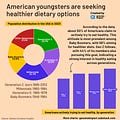Top Food Franchises Changing with Consumer Habits (Gen Y & Z) – But is it Paying Off 💸?
Fast food has had a serious glow-up.
Will fast food’s shift to healthier options win over Gen Z and Millennials?
How are fast food giants balancing innovation with rising costs?
Curious about what Tesla, Google, and Coinbase revealed in their Q3 2024 reports and the reasons behind their financial performance?
🥗 A Menu Revolution: Diversity on Demand
Gone are the days of “one-size-fits-all” menus. Today’s consumers expect variety, and fast-food giants are listening. Millennials and Gen Z are moving the needle with their demand for vegan, gluten-free, and health-conscious options. McDonald’s, for example, has taken notice. Beyond the usual Big Mac and fries, they’re testing out health-focused items and even trying sustainable packaging to cater to an eco-conscious crowd. And it’s not just McDonald’s—Starbucks and Subway are also rolling out new selections to keep up with these picky eaters.
Interestingly, despite recent concerns like the McDonald’s E. coli outbreak, which we discussed earlier this week in our free newsletter, people’s long-term perception of the brand hasn’t taken much of a hit. According to our poll, 75% of respondents said they either don’t care or will wait it out before deciding to stop eating at McDonald’s.
These shifts in consumer demands and brand loyalty are part of a broader industry trend. The quick-service restaurant (QSR) market reached an impressive $978.4 billion in 2023, showing that adapting to customer tastes can drive growth. So, for anyone still clinging to the notion of “fast food as junk food,” the times are changing fast. The franchise market is now much more colorful, featuring everything from plant-based burgers to “artisanal” bread. It’s about keeping up with the Joneses—or perhaps the Jacksons and Jennifers of Gen Z.
💸 The Luxury of a Burger
If grabbing a burger feels like a splurge these days, you're not alone. The price of convenience has skyrocketed, with a simple fast-food meal no longer being the budget-friendly option it once was. For the average $9 burger, the cost of ingredients is just $1.86, meaning customers are paying a 384% markup for their meal! So where does all that money go?
Keep reading with a 7-day free trial
Subscribe to Genuine Impact - Charting Finance, Investing & Tech to keep reading this post and get 7 days of free access to the full post archives.





